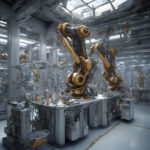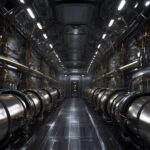Robot Arms Dismantle Record-Setting Fusion Reactor, Revealing Plasma’s Impact on Materials
The UK Atomic Energy Authority (UKAEA) has officially begun decommissioning the longest-running and most productive fusion experiment in the world. The fusion reactor, located at the Culham Centre for Fusion Energy in Oxfordshire, has been a pioneering force in the realm of nuclear fusion for over three decades. However, as the facility nears the end of its operational life, scientists and engineers are turning to cutting-edge technology to dismantle the reactor and study the effects of plasma on its internal components.
One of the most remarkable aspects of this decommissioning process is the use of robot arms to disassemble the fusion reactor. These advanced robotic systems are equipped with a wide range of tools and sensors that allow them to carefully and precisely deconstruct the reactor without causing any damage to its intricate components. By utilizing robot arms for this task, the UKAEA is not only ensuring the safety of its personnel but also gaining valuable insights into the impact of plasma on the reactor’s materials.
The plasma, which is the superheated state of matter that fuels the fusion reaction, can have a profound effect on the materials used in the reactor. Over time, the intense heat and radiation generated by the plasma can cause structural changes and degradation in the reactor’s components, potentially compromising its overall performance. By carefully analyzing the condition of the reactor’s materials during the dismantling process, scientists can better understand how plasma interacts with different substances and develop more resilient materials for future fusion reactors.
Moreover, the use of robot arms in the decommissioning process showcases the growing importance of automation and robotics in the field of nuclear energy. These sophisticated machines are not only capable of performing complex tasks with precision and efficiency but also reducing the exposure of humans to hazardous environments. As the demand for clean and sustainable energy sources continues to rise, the integration of robotics in nuclear fusion research and development will play a crucial role in advancing the field and overcoming technical challenges.
In addition to the technological advancements demonstrated in the decommissioning of the fusion reactor, the UKAEA’s commitment to transparency and collaboration is also worth noting. The organization has been actively sharing updates and insights from the decommissioning process with the international fusion community, fostering a spirit of cooperation and knowledge exchange. By engaging with researchers and experts from around the world, the UKAEA is not only enriching the global understanding of fusion energy but also paving the way for future breakthroughs in the field.
As the robot arms continue their meticulous work of dismantling the record-setting fusion reactor at the Culham Centre for Fusion Energy, the scientific community eagerly awaits the findings that will emerge from this groundbreaking endeavor. By unraveling the mysteries of plasma’s impact on materials and harnessing the power of automation, the UKAEA is poised to leave a lasting impact on the future of nuclear fusion and sustainable energy production.
fusion, robotics, nuclear energy, plasma materials, automation












